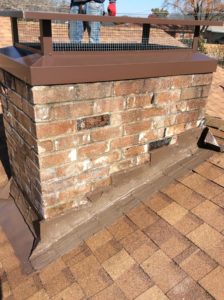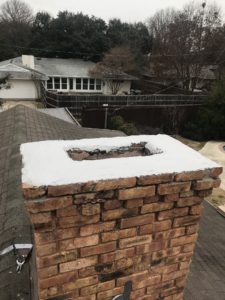What to expect from a chimney cleaning pro when hiring for a chimney sweep or an inspection.
Masters services is you chimney cleaning pro, safety inspections, and repairs in Dallas Houston Fort Worth and Oklahoma City. Our owner Chad Murray is a Certified Master Chimney Technician. John Michaud, our General Manager, is a certified chimney professional as of January 2020.
Which Comes 1st, Chimney Cleaning or a Safety Inspection?
So which comes 1st chimney cleaning or a safety inspection? Some companies will clean the chimney and then do a safety inspection. Sometimes you do have to clean the chimney to complete a safety inspection however most of the time we do not need to clean the chimney to complete a safety inspection. Here at master services we choose to inspect the chimney 1st and only clean it if the inspection requires us to see through the debris. In most cases you can see the flue is in good repair or not in good repair without cleaning the chimney. For liability reasons we do not clean the chimney giving the client false hope that their chimney is ready to use especially if it is in need of repair.
In the event the chimney has too much soot and we cannot see the chimney liner we are required to clean the chimney. The chimney liner is by NFPA 211 code required to have no cracks and be in good smooth condition. If the chimney has stage 3 creosote we will have to do Poultice Creosote Remover treatment before we can complete an inspection for usage of the fireplace and chimney.
As a client that is seeking out a chimney cleaning pro, be aware of any chimney cleaning company that does not safety inspect the chimney with a video camera going up the flue. You cannot inspect a flue above the damper with a handheld flashlight looking up through the damper. You also cannot inspect a chimney flue from the Top of the chimney by looking down the chimney flue with or without a flashlight.
In the years before becoming a certified chimney professional I used to tell the customers anything I could he set their mind at ease that I knew everything there was to know about fireplaces and chimneys. The fact is I knew about 20% of what I needed to know and looking back was scary of what I didn’t know.
Mark Twain has an excellent quote for hiring anybody is not certified in their field…
“It ain’t what you don’t know that gets you into trouble. It’s what you know for sure that just ain’t so.”
When I look at this quote now being a chimney cleaning pro that is certified I think of all the stuff I knew for sure that ended up not being right. Of course, there’s things that you don’t know that will get you in trouble but the main thing is you’ll never know what you need to know if you don’t study to find out what you will know for sure.
When hiring a chimney professional, you want to know if they know if the inspection should come first or the chimney cleaning. They will only know if they’ve had any training to become certified in the chimney industry.
What does a Certified Chimney Professional really look at when performing a Safety Inspection?
What does a certified chimney professional really look at when inspecting your fireplace and chimney. Starting with the fireplace they’re looking for…
- Cracks pausing fire hazards
- rusting parts
- loose bricks
- broken refractory panels
- correctly built dimensions of the firebox
- smoke chamber integrity
- correct hearth depth into the living room
- fireplace doors installed correctly
- Cleanliness
- smoking issues
- Firescreen coverage
- gas piping installed correctly, in good working order
- anything out of the ordinary that may need to be corrected
When looking at the chimney the inspection includes…
-
- Flashing present an installed correctly
- Chimney chase free of cracks, sealed properly
- Mortal Crown free of cracks, completely covering the Top of the chimney

- Factory made chimneys have a chase cover, storm collar, UL listed termination cap
- Chimney cap is present, properly functioning as a spark arrestor, acting as an animal, and moisture guard
- Structure has good integrity
- Anything out of the ordinary that may need to be corrected
Knowing what to look for and then knowing how to correct any infractions and or code violations is what certified professionals have proven to have knowledge of’.
What does a Certified Chimney Professional Learn?
A certified chimney professional studies the NFPA 211 Standard for chimneys, fireplaces, vents, and solid fuel burning appliances manual. CCP has also created its own manual to stand with the NFPA 211. All the codes that most cities and states add here too for fire safety is in these 2 manuals. To get certified a chimney professional has studied and taken a test in which he must pass to get their certification. It is not required to be certified to work on your chimney and fireplace in most states. As scary as that sounds, it makes it even more important for any homeowner to make sure they hire the correct professional for their safety.
Beware of anybody claiming to know everything about a fireplace and chimney if they are not certified. Many chimney businesses that offer inspection services have worked for certified professionals. These rogue companies have not studied or proven they know anything about fire safety. It says a lot about somebody that takes it upon themselves to pay, study, and pass a test that is not required to get better in their industry.
An example of what I learned after being certified is that chimney caps are required by code to be installed on every chimney. Many man-made masonry chimneys have been built that do not have a chimney cap.

Countless times when inspecting a chimney, homeowners have questioned why Masters Services was requiring a cap to pass inspection when a chimney cap was not installed at the time of the home being built. There are many Dallas chimney caps and Houston chimney caps needing to be installed on chimneys that have never had a cap installed.

How to do a Chimney Cleaning
Chimney cleanings, otherwise known as a chimney sweep, should only be performed by someone trained to clean a chimney. It can be very hazardous to clean a chimney wrong. Soot, animal debris, or a live animal may enter the house too fast. Even having a professional chimney cleaning vacuum does not stop soot from dusting the house if you don’t know what you’re doing.
The steps to clean a chimney…
- Cover or tarp as much of the room the fireplace is in as necessary to place your equipment on or to protect any furniture or a household treasures.
- Bring in all equipment. make sure all equipment is clean from the last usage.
- Run a pole with a sweeps brush up the chimney to the top.
- Continue running brush up and down as many times as necessary until no soot or debris is falling.
- Clean the smoke shelf and smoke chamber.
- Take the brush and poles outside.
- Clean the damper.
- Clean all 3 sides of the firebox.
- Clean the lintel.
- Clean the grate.
- Vacuum out all debris on the fireplace floor.
- Take all the equipment and tarps outside
Cleaning a chimney step by step seems to be an easy process however if not done correctly can lead to costly clean up fees. Not just knowing how to clean a chimney but also having the correct equipment is the main reason one should hire a chimney cleaning pro.
What chimney repairs can I expect I may need?
Chimney repairs that you may expect to need include a new flue liner, tuck pointing cracks, loose or missing bricks, rusting flashing that needs replacing or sealing, mortar crown enforcement, and possibly rebuilding the chimney.

A chimney flue liner is a big part of having a safe fire in you are chimney. The flue liner must be free of cracks, solid, and smooth going up from the smoke chamber to the top of the chimney. There are several ways in getting your flue liner up to code. Some companies have a flue lining machine that sprays lining mortar up and down the chimney flue. Other companies use a flue cone method. They pour lining mortar down a chimney and bring up a flu cone up designed to line the flue walls. A third possible way of lining a chimney flue is too add a metal lining into the existing flue. There are other methods of lining a flue, but these are the most common.
Of the three methods none of them in my opinion are better than the other. If the end result is you have a solid, smooth, and crack free up to code flue liner then whichever method achieve this was the right method for your chimney.
Tuck pointing cracks is necessary to seal up and interior and exterior issues. It’s pretty obvious why you would fix cracks. A chimney cleaning pro would know exactly how to repair any chimney cracks correctly. Loose and missing brick should be replace as soon as it occurs. Roofer may help in the seeing the chimney flashing needs replacing. Mortar crowns should have a fresh layer of mortar every few years or may even need to be rebuilt.
In extreme cases the chimney may need to be torn down and rebuilt. Rebuilding a chimney is typically caused from moisture penetration. Not having a chimney cap, not having the chimney chase waterproofed, and or not keeping up with general deterioration over time are the causes of minor repairs leading up to chimney rebuilds.
Best questions to Ask a Chimney Pro Before Hiring?
The best question to ask a chimney service is absolutely “Are you Certified?”. Hands down if the answer is “No” then move on the next chimney service provider.
It is always a good question to ask if they have liability insurance.
Masters Services performs all these chimney and fireplace repairs. If you need a chimney cleaning pro call us at 972-877-4650 or 713-723-4854 to schedule a free estimate or a safety inspection.